Are you a beginner aquarist and want to put a boy tetra in your aquariums? But you failed to do so because you don’t know the gender of tetras. For this reason, we come up with some suitable ways by which you can easily differentiate between a boy and a girl tetra fish. Before that, we will cover some general information about tetras.
Content Table
What Are Tetra Fish?
Tetra fish are small fish that are often kept in aquariums. They survive in a variety of water conditions, and they are easy to look after. It makes them a great ornamental fish for beginner aquarists.
Tetra fish are also very colorful because they come in various shapes and sizes, so they fit every freshwater aquarium. Although they may be small, these fish can add color that your tank lacks.
Their diet should consist of flake food and live food, but should not contain more than 10% vegetable or fruit content as it can lead to intestinal problems. Tetras are carnivorous bottom-dwellers, spending most of their time at the bottom of the tank and eating different insects and worms.
What Is the Origin of Tetra Fish?
Tetras belong to the group called Characins, which swim in schools. They are often found in tropical South American waters and live in freshwater lakes, rivers, and streams, with some species living in brackish water in estuaries along coastlines.
Since the tetra fish is a freshwater fish species and only occasionally enters saline waters, you will never find them in the ocean or seawater.
According to scientists, there are currently over 180 species of tetras. The majority of tetras used by aquarium hobbyists come from just three species: the Black phantom tetra (Hyphessobrycon Megaloptera), Silver tetra (Ctenobrycon spilurus), and the Cardinal tetra (Paracheirodon axelrodi).
An Interesting Fact About Tetras
An interesting fact about tetras is that most of them can adjust their color according to their surroundings. That is because they have five types of cones that perceive light in five different wavelengths, so they can identify other fish species and predators by analyzing the color spectrum reflected by their skin.
The color of the tetras is colorful, especially the red, blue, or green light, which can reflect the lighting and make tetras known as “the swimming gem”. Special attention to aquarium light is required for them, most tetras are afraid of strong light and interference, so the full spectrum LED grow lights with sunset and sunrise modes are more suitable for tetras.
5 Awesome Types of Tetras
Let’s discover together some unique types of Tetras.
Neon tetra
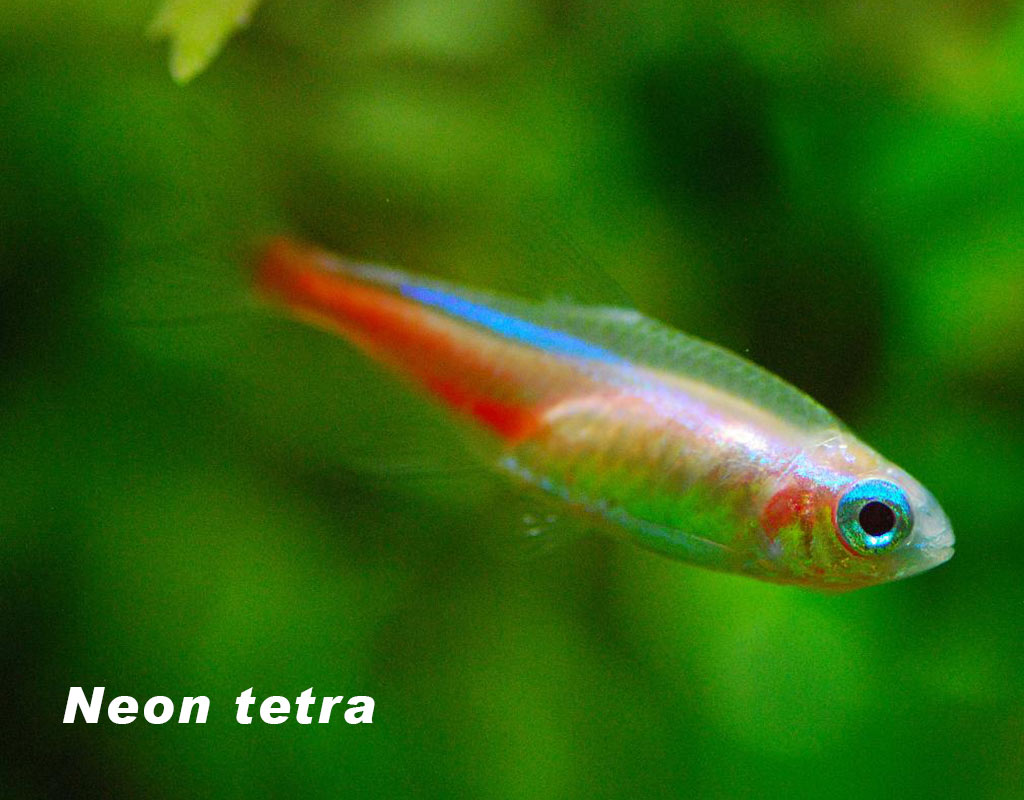
Neon tetra
The neon tetra fish is a peaceful species and native to the Amazon Basin and some Caribbean islands. They are an omnivorous species, eating plant and animal matter when given the opportunity. Neon tetra fish is a popular and sought-after species in the aquarium hobby because of their brilliant colors and peaceful nature. The neon tetra comes in many colors and sizes, including red neon tetras, black neon tetras, green neon tetras, blue neon tetras, white neon tetras, and yellow neon tetras. Some varieties also come in a phase where they will change colors.
Black skirt tetra
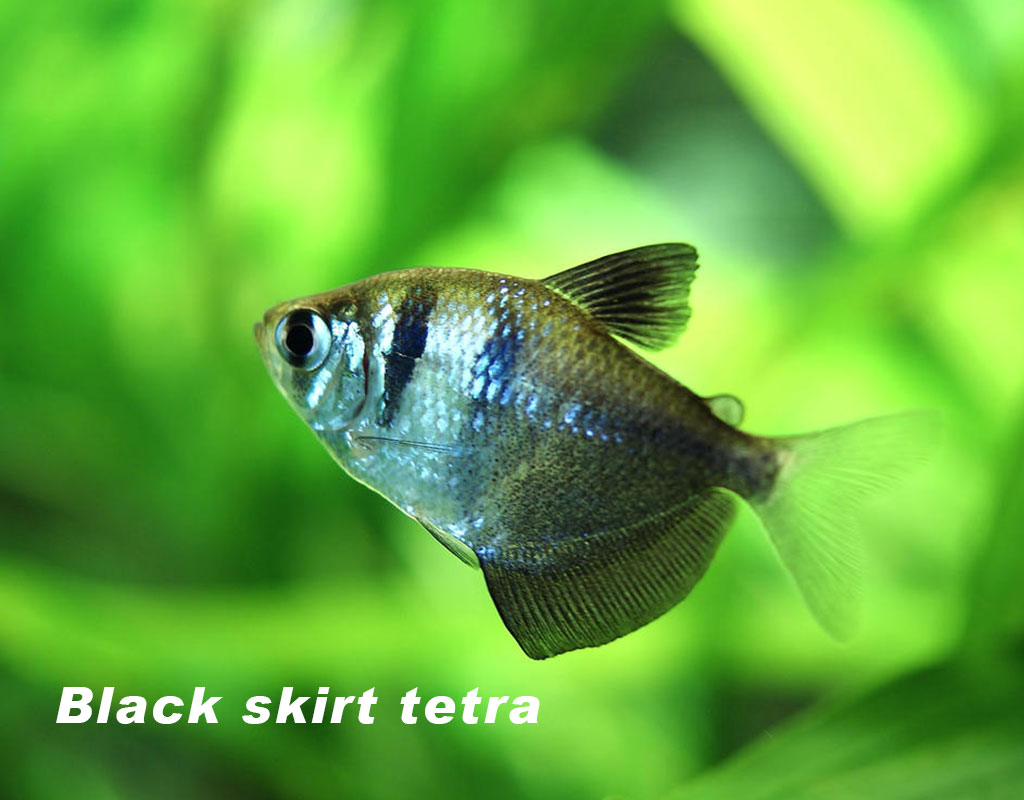
Black skirt tetra
It is a small fish but has a beautiful look. It is named black skirt tetra because it has a broad black stripe on the ventral side of the fish, and it looks like a skirt when it swims. This fish variety grows to about 5.5 centimeters long and is very popular among aquarists because of its distinct coloration. Just like other tetras, this variety is peaceful and can be kept with other small varieties, but it better not keep with fish having long fins. It thrives best in moderately soft water in the range of 25–30 °C.
Black skirt tetra fish is an active feeder and will take flake food or frozen food as treats. This variety can be kept alone or in pairs, and shoals of 5 to 10 fishes are ideal for them as they thrive best in groups.
Lemon tetra
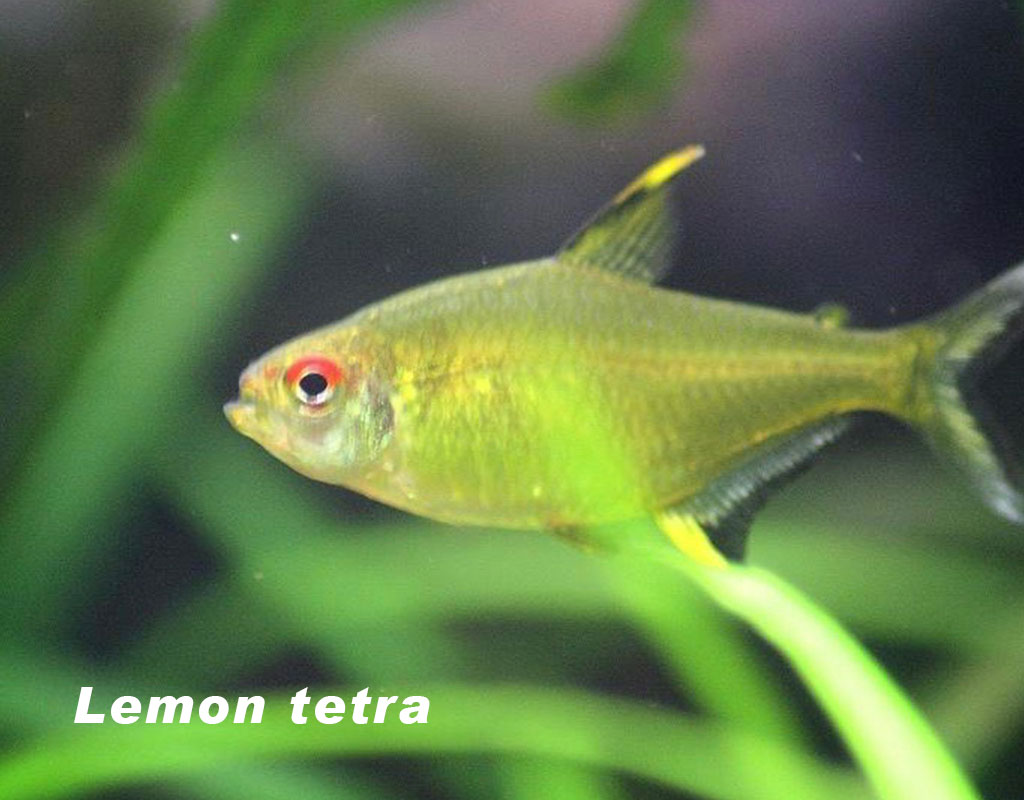
Lemon tetra
The lemon tetra fish is the common name for the species of freshwater fish from South America. It is found in the Orinoco and Amazon basins in Venezuela and Colombia, as well as rivers in Trinidad, Guyana, Suriname, and Brazil.
The lemon tetra is extremely popular in the aquarium trades, as it is a small, colorful, active species that is easy to keep. It grows to a maximum length of 3 cm (1 in). The fish possess small mouths and large eyes and adapt to feed on small insects that settle on plants or drift nearby. Lemon tetra fish has the potential to grow in size. While young, the maximum size they can grow to is three inches long, and their weight can be up to two ounces. But once they mature, they can grow up to five inches long and weigh up to 14 ounces.
Dawn tetra
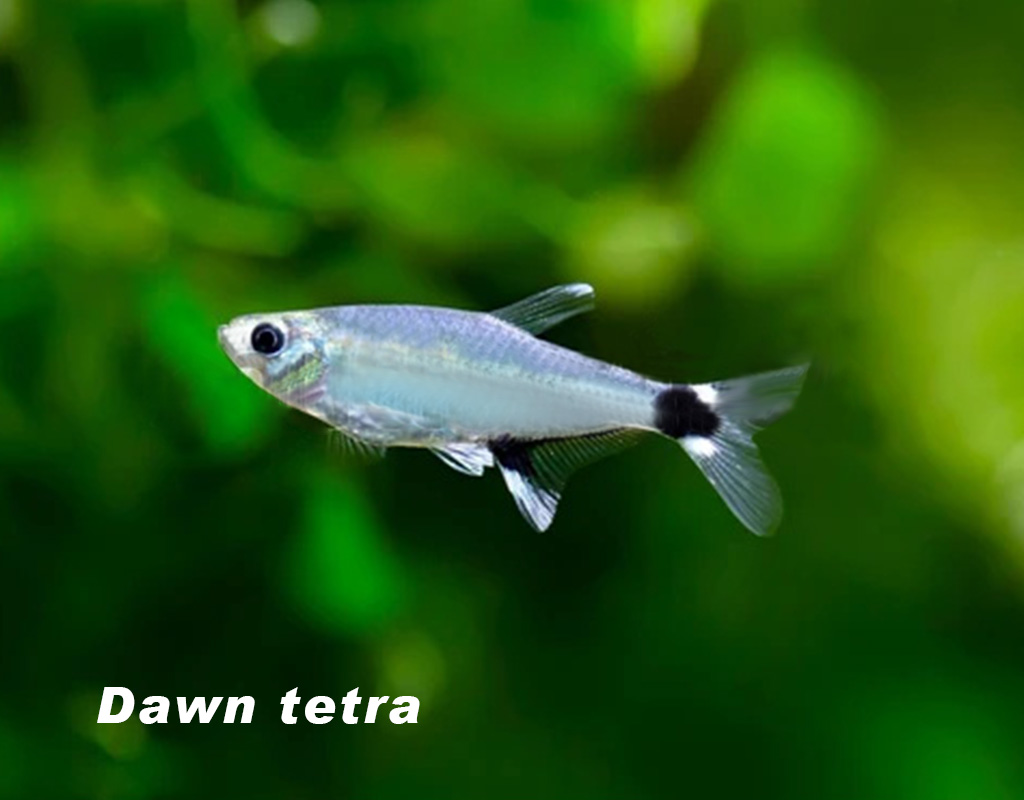
Dawn tetra
Popularly known as pygmy tetra fish, dawn tetra is a bottom dweller found in South America. It is colored bright orange with black stripes on its body. The fish is friendly, lively, and easy to keep inside your aquarium. This small tropical tetra fish has a lifespan of around 5–10 years when kept in a good environment. It grows to the size of 1.5 inches. You can easily raise the fish in large numbers and simply feed them with flake foods or small pieces of other live foods. This species comes in a wide range of colors, both metallic and nonmetallic, and is also very hardy and disease-resistant.
Ember tetra
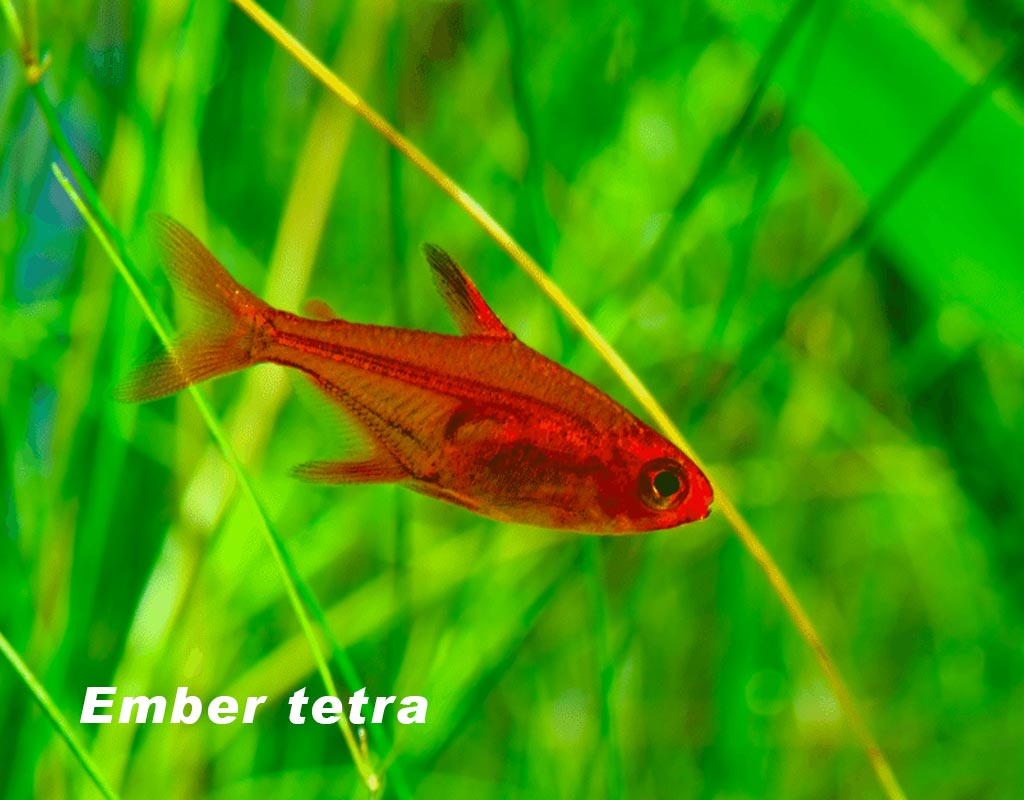
Ember tetra
As an amazing freshwater fish, ember tetra is scientifically termed Hyphessobrycon amandae. It is a member of the panorama tetra family and is an inhabitant of the Paraguay River and its tributaries. The ember tetra fish has a deep blue color with orange-yellow fins and tails. It is one of the easiest freshwater fish to maintain, probably because it is easy to breed; this, in turn, makes it a popular choice for tetra fish lovers. Fluorescent lights are not necessary for keeping ember tetra fish since they live in soft, acidic water.
How Do Identify a Boy or Girl Tetra?
Having many tetras can create quite the visual for your tank, but one of the biggest questions you may have is: How do you tell the differences between a male tetra and a female tetra?
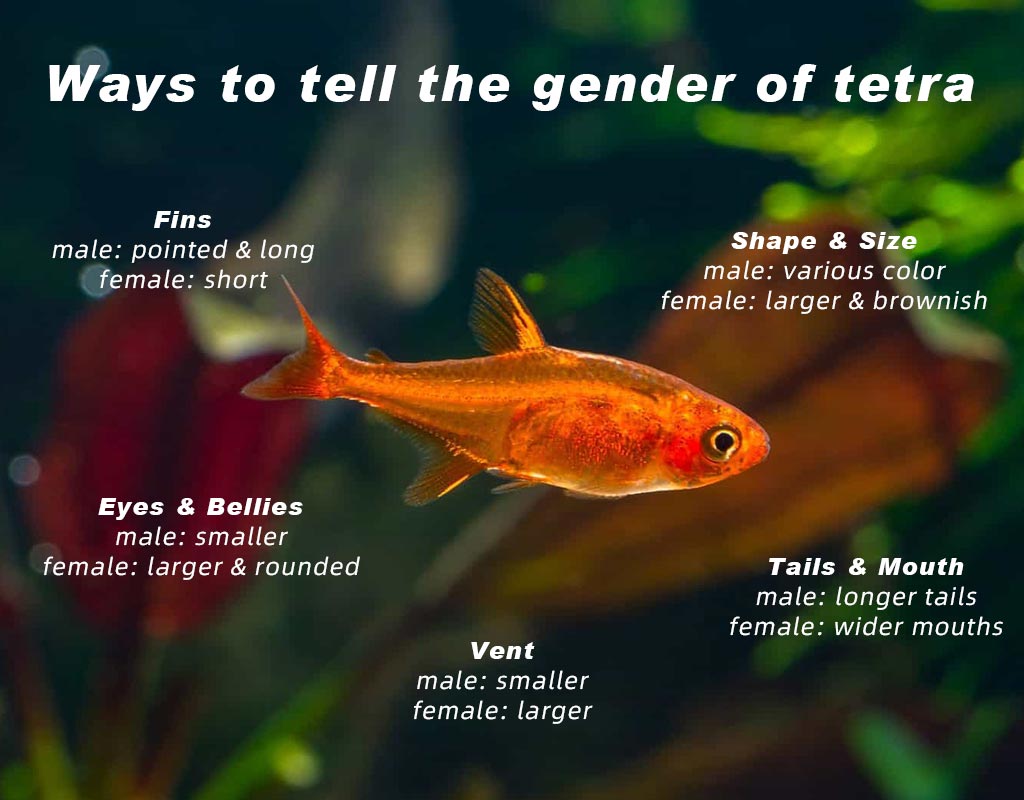
Ways to tell the gender of tetra
With fins
The fins will provide all the clues you need. The male’s fins are more pointed and have a longer dorsal fin. The female’s dorsal fin is short.
Shape and size
You may also be able to see differences in body shape or size. They both have one thing in common: Females are usually larger than males. The males and females are different in external appearance: the male has a larger body color, depending on the variety of grayish, green, or bluish; the female is smaller and brownish.
Eyes and bellies
Female tetras have larger eyes and rounded bellies. And it distinguishes them from males. Males also tend to be smaller than females.
With tails and mouth
Males have longer tails than females. Also, if you look at their mouths, you will notice that females’ mouths are wider than the males.
Identification via vent
An effective way to identify female and male tetra is by inspecting the vent (linking pectoral and fins), or you can roll on its back. In female tetra, you would see a slightly larger vent for passing eggs. However, the male tetras’ vent is to release semen to feed eggs, which are smaller than that of the female tetras.
Let Your Tetra Fish Live Peacefully
Many people like to keep tetra fish in their fish tanks. They look pretty elegant and beautiful in the water. Besides, they can grow well in the tank containing live plants, stones, and other aquarium decor items. The tank having tetra fish looks very artistic and beautiful. And there are some ways to make your tetra fish live peacefully in the tank.
- The best way to leave your Tetra aquarium peacefully is to keep it in a cool place away from direct sunlight. The ideal room temperature is between 15 and 20 degrees Celsius.
- The most important thing for a happy tetra fish is that it doesn’t feel hungry or thirsty. If your tetra fish feel bad, it’s probably because of these two problems: food or water.
- You can solve both problems by adding some plants, driftwood, or decoration to your tetra tank. When your tetra fish sees a lot of food, it will start eating and will be comfortable. If you have a lot of plants in your tank, your tetra will go first in them to hide and then will start eating.
Conclusion
In the article, we have covered detailed information about tetra fish origin and some vibrant tetras that you can put in your aquarium with minimum care. Later in the article, we provided some ways to identify the male and female tetras to separate them with ease. Finally, we mentioned some key points on how aquarists can keep their tetras living peacefully in the tank.
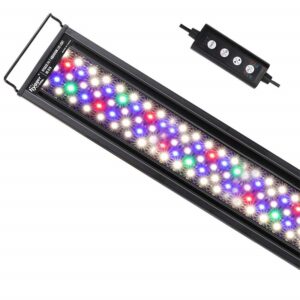
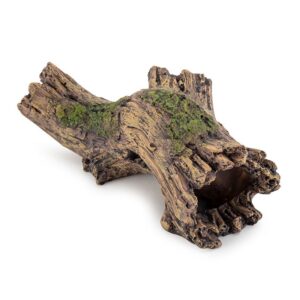
Determine sex of glofish tetra